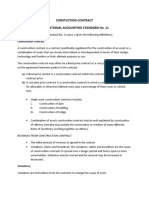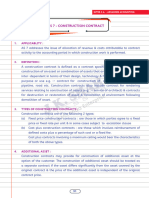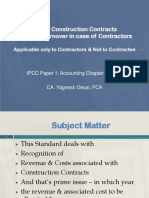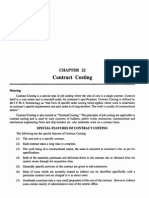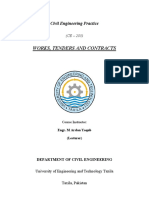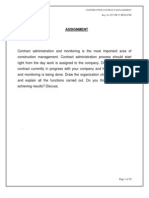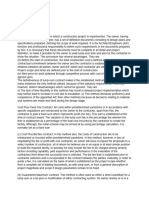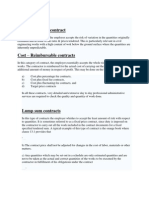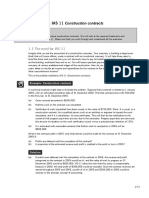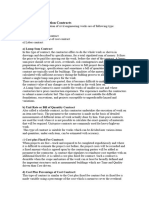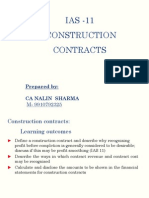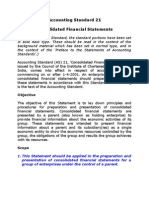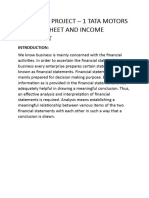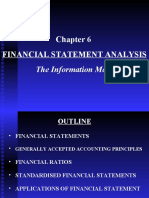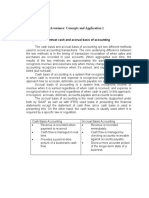Bkaf3093 Topic 7 Construction Sept2016
Bkaf3093 Topic 7 Construction Sept2016
Uploaded by
pitot cuteCopyright:
Available Formats
Bkaf3093 Topic 7 Construction Sept2016
Bkaf3093 Topic 7 Construction Sept2016
Uploaded by
pitot cuteOriginal Description:
Copyright
Available Formats
Share this document
Did you find this document useful?
Is this content inappropriate?
Copyright:
Available Formats
Bkaf3093 Topic 7 Construction Sept2016
Bkaf3093 Topic 7 Construction Sept2016
Uploaded by
pitot cuteCopyright:
Available Formats
ACCOUNTING FOR
CONSTRUCTION CONTRACTS
Topic 3 - Construction contract 1
To understand the nature of Construction
Contracts (CC)
To discuss the accounting issues related with
treatment and recognition in Construction
Contracts industry
To know the presentation and disclosure
requirement of the CC financial statements
Topic 3 - Construction contract 2
Introduction
Definitions of terminology
Nature and activity of industry
Current Regulations and Standards
Types of Contract
Fixed Price Contract
Cost Plus Contract
Combining and Segmenting Construction
Contract
Combining Construction Contract
Segmenting Construction Contract
Contract Costs
Topic 3 - Construction contract 3
Contract Revenues
Determination and Valuation
Recognition
Presentation and Disclosure Requirement
Conclusion
References
Discussion Questions
Tutorial Questions
Topic 3 - Construction contract 4
Comprise of a complex combination of peoples, plants,
materials, locations, technology and knowledge of the
law.
Covers a wide range of activities from the building of
dams to office blocks, housing, infrastructure project,
etc.
Involved many parties includes construction owner, sub-
contractor, architect, engineer, lawyer, etc.
Because of their nature, normally this industry covers
more than one accounting period.
The main issue facing by the accountant in this industry
are related with the allocation of costs and revenues
derived to the particular period in which construction
work is performed.
Topic 3 - Construction contract 5
Construction contract a contract specifically
negotiated for the construction of an assets or
combination of assets that are closely interrelated in
term of design, technology and function or their
ultimate purpose or use.
Fixed price contract a construction contract in
which the contractor agrees to a fixed contract price
or a fixed rate per unit of output.
Cost plus contract - a construction contract in which
the contractor is reimbursed for allowable or
otherwise defined costs, plus a percentage of these
costs or a fixed rate.
Contract revenue consist of initial amount of
revenue agreed in the contract and variation in
contract work, claims and incentive payment.
Topic 3 - Construction contract 6
Claims an amount that the contractor seeks
to collect from the customer or another
party as a reimbursement for costs not
included in contract price.
Incentives additional amount paid to
contractor if specific performance standard
are met or exceeded.
Progress billing amounts billed for work
performed on a contract whether or not the
customer has paid them.
Advances are amount received by the
contractor before the related work is
performed.
Topic 3 - Construction contract 7
Normally involved various parties.
Covers wide range of works.
Complex combination of people, plant, technology,
machine, materials and knowledge of law.
Starting date and completion/end date usually fall
into different accounting period.
Topic 3 - Construction contract 8
The current effective accounting standards is
MFRS 111 which is become operative starting
1st January 2012.
is FRS 111, Accounting for
Previously
Construction Contract
IAS11 (revised) and MASB 7.
Main purpose of the MFRS 111 is to prescribe
the accounting treatment of revenue and costs
associated with construction contracts.
Topic 3 - Construction contract 9
A fixed price contract - is a construction
contract in which the contractor agrees to a
fixed contract price, or a fixed rate per unit of
output, which in some cases is subject to cost
escalation clauses.
A cost plus contract- is a construction contract
in which the contractor is reimbursed for
allowable or otherwise defined costs, plus a
percentage of these costs or a fixed fee
Topic 3 - Construction contract 10
Contract revenues comprises of:
(a) the initial amount of revenue agreed in the
contract
(b) variations in contract work, claims and incentive
payments:
(i) to the extent that it is probable that they will
result in revenue; and
(ii) they are capable of being reliably measured.
Contract revenue is measured at the fair value of
the consideration received or receivable.
The measurement of contract revenue is affected
by a variety of uncertainties that depend on the
outcome of future events.
Topic 3 - Construction contract 11
Variation Claim Incentive Payment
A variation is an A claim is an amount Incentive payments
instruction by the that the contractor are additional
customer for a change seeks to collect from amounts paid to the
in the scope of the the customer or contractor if specified
work to be performed another party as performance
under the contract. reimbursement for standards are met or
Examples of costs not included in exceeded.
variations are changes the contract price. For example, a
in the specifications A claim may arise contract may allow
or design of the asset from, customer for an incentive
and changes in the caused delays, errors payment to the
duration of the in specifications or contractor for early
contract. design, and disputed completion of the
variations in contract contract.
work.
Topic 3 - Construction contract 12
In the case of a fixed price contract, the outcome of
a construction contract can be estimated reliably
when all the following conditions are satisfied:
(a)total contract revenue can be measured reliably;
(b)it is probable that the economic benefits
associated with the contract will flow to the entity;
(c)both the contract costs to complete the contract
and the stage of contract completion at the balance
sheet date can be measured reliably; and
(d)the contract costs attributable to the contract can
be clearly identified and measured reliably so that
actual contract costs incurred can be compared with
prior estimates.
Topic 3 - Construction contract 13
In the case of a cost plus contract, the
outcome of a construction contract can be
estimated reliably when all the following
conditions are satisfied:
(a)it is probable that the economic benefits
associated with the contract will flow to the
entity; and
(b)the contract costs attributable to the
contract, whether or not specifically
reimbursable, can be clearly identified and
measured reliably.
Topic 3 - Construction contract 14
Contract costs shall comprise:
(a) costs that relate directly to the
specific contract
(b) costs that are attributable to
contract activity in general and can
be allocated to the contract
(c) such other costs as are
specifically chargeable to the
customer under the terms of the
contract
Topic 3 - Construction contract 15
Costs that relate directly (DC) to a specific contract include:
(a) site labour costs, including site supervision;
(b) costs of materials used in construction;
(c) depreciation of plant and equipment used on the
contract;
(d) costs of moving plant, equipment and materials to and
from the contract site;
(e) costs of hiring plant and equipment;
(f) costs of design and technical assistance that is directly
related to the contract;
(g) the estimated costs of rectification and guarantee work,
including expected warranty costs; and
(h) claims from third parties.
Topic 3 - Construction contract 16
Coststhat may be attributable (indirect cost)
to contract activity in general and can be
allocated to specific contracts include:
o (a) insurance
o (b) costs of design and technical assistance that
are not directly related to a specific contract
o (c) construction overheads
o (d) borrowing costs
The allocation is based on the normal level
of construction activity.
Topic 3 - Construction contract 17
Costs that cannot be attributed to contract
activity or cannot be allocated to a contract are
excluded from the costs of a construction
contract(non-allocated cost-NAC). Such costs
include:
(a) general administration costs for which
reimbursement is not specified in the contract
(b) selling costs
(c) research and development costs for which
reimbursement is not specified in the contract
(d) depreciation of idle plant and equipment that
is not used on a particular contract.
Topic 3 - Construction contract 18
The requirements of this Standard are usually
applied separately to each construction
contract. However, in certain circumstances, it
is necessary to apply the Standard to the
separately identifiable components of a single
contract or to a group of contracts together in
order to reflect the substance of a contract or a
group of contracts.
Topic 3 - Construction contract 19
When a contract covers a number of assets, the
construction of each asset shall be treated as a
separate construction contract(SCT) when:
(a)separate proposals have been submitted for
each asset;
(b)each asset has been subject to separate
negotiation and the contractor and customer
have been able to accept or reject that part of
the contract relating to each asset; and
(c)the costs and revenues of each asset can be
identified.
Topic 3 - Construction contract 20
A group of contracts, whether with a single
customer or with several customers, shall be
treated as a single construction contract when:
(a)the group of contracts is negotiated as a
single package;
(b)the contracts are so closely interrelated that
they are, in effect, part of a single project with
an overall profit margin; and
(c)the contracts are performed concurrently or
in a continuous sequence.
Topic 3 - Construction contract 21
A contract may provide for the construction
of an additional asset at the option of the
customer or may be amended to include the
construction of an additional asset. The
construction of the additional asset shall be
treated as a separate construction contract
when:
(a)the asset differs significantly in design,
technology or function from the asset or
assets covered by the original contract; or
(b)the price of the asset is negotiated
without regard to the original contract price.
Topic 3 - Construction contract 22
The estimates often need to be revised as events occur and
uncertainties are resolved. Therefore, the amount of contract
revenue may increase or decrease from one period to the next.
For example:
(a) a contractor and a customer may agree to variations or
claims that increase or decrease contract revenue in a
period subsequent to that in which the contract was
initially agreed;
(b) the amount of revenue agreed in a fixed price contract
may increase as a result of cost escalation clauses;
(c) the amount of contract revenue may decrease as a result
of penalties arising from delays caused by the
contractor in the completion of the contract; or
(d) when a fixed price contract involves a fixed price per
unit of output, contract revenue increases as the number
of units is increased.
Topic 3 - Construction contract 23
When the outcome of a construction contract can be
estimated reliably, contract revenue and contract
costs associated with the construction contract shall
be recognized as revenue and expenses respectively
When the outcome of a construction contract cannot
be estimated reliably:
(a) revenue shall be recognized only to the extent of
contract costs incurred that it is probable will be
recoverable; and
(b) contract costs shall be recognized as an expense in
the period in which they are incurred.
Contract costs that are not probable of being
recovered and expected loss on the construction
contract shall be recognized as an expense
immediately.
Topic 3 - Construction contract 24
Anentity is generally able to make reliable
estimates after it has agreed to a contract
which establishes:
Each partys enforceable rights regarding the
assets
The consideration to be exchanged
The manner and terms of settlement
Topic 3 - Construction contract 25
The recognition of revenue and expenses by reference to the stage of
completion of a contract is often referred to as the percentage of completion
method.
Under this method, contract revenue is matched with the contract costs
incurred in reaching the stage of completion, resulting in the reporting of
revenue, expenses and profit which can be attributed to the proportion of work
completed.
The stage of completion of a contract may be determined in a variety of ways.
The entity uses the method that measures reliably the work performed.
Depending on the nature of the contract, the methods may include:
(a) the proportion that contract costs incurred for work performed to date
bear to the estimated total contract costs; Cost Based Method
(b) surveys of work performed; or
(c) completion of a physical proportion of the contract work.
(b) and (c) - Value Based Methods
Progress payments and advances received from customers often do not reflect
the work performed.
Topic 3 - Construction contract 26
Expected losses occur when total contract costs
exceed total contract revenue.
An expected loss shall be recognized as an
expense immediately in accordance with
paragraph 36 of MFRS111.
The amount of these expected losses is
determined irrespective of;
Whether work has commenced on the contract
the stage of completion of contract activity
the amount of profits expected to arise on other
contracts which are not treated as a single
construction contract in accordance with paragraph
9.
Topic 3 - Construction contract 27
Anyeffect from the changes of the contract
revenue or costs due to the determination of
the percentage of completion should be
treated as a changes in accounting
estimation (MFRS 108 Accounting Policies,
Changes in Accounting Estimates and Errors).
Topic 3 - Construction contract 28
Must be accordance to MFRS 101
The Balance sheet should classify the assets and
liabilities based on current and non current.
Thestatement of comprehensive income should
present:
Revenues
Finance costs
Share of profits and losses of associates and joint
ventures accounted
Tax expense
Profit or loss
Topic 3 - Construction contract 29
Disclosure Requirement
An entity shall disclose:
a) The amount of contract revenue recognized as
revenue in the period.
b) The method used to determine the contract
revenue recognized in the period
c) The method used to determine the stage of
completion of contracts in progress.
Topic 3 - Construction contract 30
Examples of Accounting Policy
Disclosures
The following are examples of accounting policy
disclosures:
Revenue from fixed price construction contracts is
recognised on the percentage of completion method,
measured by reference to the percentage of labour hours
incurred to date to estimated total labour hours for each
contract.
Revenue from cost plus contracts is recognised by
reference to the recoverable costs incurred during the
period plus the fee earned, measured by the proportion
that costs incurred to date bear to the estimated total costs
of the contract
Topic 3 - Construction contract 31
Disclosure of construction Contracts in Progress
For contracts in progress, at the balance sheet date, para 41
of FRS111 stated that an entity shall disclose:
a) The aggregate amount of costs incurred and recognised
profits (less recognised losses) to date.
Note that if the net amount of the above is a positive
figure, the construction in progress should be shown
under the current assets, otherwise it should shown
as current liability.
Also, if one contract has a positive figure, i.e. gross
amount due from customer, and another has a
negative figure, i.e. gross amount due to customer
for contract work they should be shown seperately
b) The amount of advances received
c) The amount of retentions.
Topic 3 - Construction contract 32
Retentions
-the amounts of progress billing that are not paid until the
satisfaction of conditions specified in the contract for the
payment of such amounts or until defects have been
rectified.
Progress billings
-the amounts billed for worked performed for work
performed on a contract whether or not they have been
paid by the customer..
Advances
-The amounts received by the contractor before the
related work is performed
Topic 3 - Construction contract 33
Presentation of Construction Contract
An entity shall present:
a) The gross amount due from customers for contract work as
asset.
b) The gross amount due to customers for contract work as
liability.
The gross amount due from customers for contract work is the
net amount of:
a) Costs incurred plus recognized profits
b) The sum of recognized losses and progress billings
for all contracts in progress for which costs incurred plus
recognized profits (less recognized losses) exceeds progress
billings.
Topic 3 - Construction contract 34
The gross amount due to customers for contract work is
the net amount of:
a) Costs incurred plus recognized profits
b) The sum of recognized losses and progress billings.
for all contracts in progress for which progress billings
exceed costs incurred plus recognized profits (less
recognized losses).
Topic 3 - Construction contract 35
Disclosure
An entity also shall discloses any contingent
liabilities and contingent assets in accordance
with FRS 137 Provisions, Contingent Liabilities
and Contingent Assets. Contingent liabilities
and contingent assets may arise from such items
as warranty costs, claims, penalties or possible
losses.
Topic 3 - Construction contract 36
-construction contract is a contract specifically
negotiated for the construction of an asset or a
combination of assets that are closely interrelated or
interdependent in terms of their design, technology and
function or their ultimate use or purpose.
-Normally, the construction activities involve more than
one accounting period.
-Main accounting issue in this industry is related with
the allocation of contract revenue and contract costs to
the accounting periods in which construction work is
performed.
Topic 3 - Construction contract 37
1. MFRS 111
2. The Nature of Construction Contract. Retrieved on November 19,
2011 from http://www.palgrave.com/PDFs
3. Introduction to Construction Contract Administration. Retrieved on
November 19, 2011 from http://media.wiley.com
Topic 3 - Construction contract 38
Example 1 - Construction Contract Accounting using
Value Based Approach
ABC Builders Bhd is a construction firm. It enters into a 2
year contract for the construction of a building for one of its
customers. ABC Builders Bhd estimates stage of completion
on the basis of value of work completed. Following
information is available in respect of the contract at the end
of first year:
Topic 3 - Construction contract 39
RM
Total Contract Price 2,000,000
Total Expected Costs 1,200,000
Costs incurred to Date 800,000
Value of work certified as complete 1,000,000
Amount billed to customer 900,000
Progress payments received from
700,000
customer
Topic 3 - Construction contract 40
Step 1 - Determine Expected Outcome of the Contract
As the total contract revenue (RM2m) exceeds total
expected contract costs (RM1.2m), the contract is
expected to be profitable. Therefore costs and revenue
be accounted for using stage of completion method.
Total Profit under the contract is expected to be
RM800,000.
Topic 3 - Construction contract 41
Step 2 - Calculate the Stage of Completion
Stage of completion may be calculated as
follows:
Stage of Completion % = [ RM1,000,000 /
RM2,000,000] x 100 = 50 %
Topic 3 - Construction contract 42
Step 3 - Determine the amounts to be recognized
in Income Statement for Profit, Revenue and Cost
When stage of completion is calculated using
value based method, revenue to be recognized is
equal to the value of work certified as complete.
Profit is calculated based on the percentage of
completion of the contract whereas cost
recognized in the income statement is the
balancing amount arrived by calculating the
difference between revenue and profit.
Topic 3 - Construction contract 43
RM
Revenue (Value of work Certified) 1,000,000
Profit (800,000 x 50%) 400,000
(Balancing Amount: [1,000,0000 -
Cost (600,000)
400,000])
Topic 3 - Construction contract 44
Step 4 - Calculate amounts to be
recognized in the Balance Sheet for Gross
Amounts due to/ from Customers and Trade
Receivables
Trade Receivables are calculated finding the
difference between amount billed to the
customer for progress payments and the
amount of progress payments received from
the customer.
Trade Receivable of ABC Builders Bhd should
therefore be calculated as follows:
Topic 3 - Construction contract 45
Trade Receivable = 900,000 (Amount Billed) - 700,000
(Amount Received) = RM200,000
Gross Amount due from Customers is calculated by
deducting the amount billed to customer (along with
any losses recognized) from the sum of profit
recognized and costs incurred to date.
Gross Amount due from Customers of ABC Builders Bhd
must therefore be calculated as follows:
Gross Amount due from Customer = 400,000 (Profit) +
800,000 (Cost Incurred) - 900,000 (Amount Billed) = RM
300,000
Topic 3 - Construction contract 46
Step 5 - Prepare Extracts of Financial Statements in respect of
Construction Contracts
ABC Builders Bhd
Income Statement (Extracts for the Year 1)
RM
Revenue 1,000,000
Cost (600,000)
Profit 400,000
Topic 3 - Construction contract 47
ABC Builders Bhd
Balance Sheet (Extracts at the end of the Year 1)
Current Assets RM
Trade Receivables 200,000
Gross Amount due from Customers 300,000
Topic 3 - Construction contract 48
Step 6 - Prepare Construction Contract
Control Account
Although not a part of the double entry
system, control accounts may be useful to
confirm the overall accuracy of accounting
entries relating to construction contracts.
ABC Builders Bhd's control account would
appear as follows:
Topic 3 - Construction contract 49
Contract Control Account
Debit RM Credit RM
Revenue
1,000,000 Cost Recognized 600,000
Recognized
Amount Received
Costs Incurred 800,000 700,000
from customer
Trade Receivable 200,000
Amount due from
300,000
customer
1,800,000 1,800,000
Topic 3 - Construction contract 50
You might also like
- Lump Sum Contract PDFDocument3 pagesLump Sum Contract PDFAmine LehtihetNo ratings yet
- Fa - Topic 3 Contract AccountDocument9 pagesFa - Topic 3 Contract AccountERICK ABDINo ratings yet
- ContrsctDocument23 pagesContrsctMohammed Naeem Mohammed NaeemNo ratings yet
- Contract DocumentsDocument41 pagesContract Documentsrowlingsndiko15No ratings yet
- Accounting For Long Term Construction ContractsDocument34 pagesAccounting For Long Term Construction Contracts수지100% (1)
- Construction Contracts An AnalysisDocument29 pagesConstruction Contracts An Analysisemmanuel JohnyNo ratings yet
- Week 10 Revenue Recognition-Long-term Construction Contract - ACTG341 Advanced Financial Accounting and Reporting 1Document12 pagesWeek 10 Revenue Recognition-Long-term Construction Contract - ACTG341 Advanced Financial Accounting and Reporting 1Marilou Arcillas PanisalesNo ratings yet
- Scope: Construction ContractsDocument6 pagesScope: Construction ContractsbilalnazeerNo ratings yet
- Contrat de ConstructionDocument36 pagesContrat de Constructionadelsahli140No ratings yet
- Week 7: Conventional Contractual Arrangement I (7.0) : 7.1 Traditional Types of ContractDocument5 pagesWeek 7: Conventional Contractual Arrangement I (7.0) : 7.1 Traditional Types of ContractAmulie JarjuseyNo ratings yet
- AS 7 - Construction ContractDocument13 pagesAS 7 - Construction Contractsourabhgoyal3075No ratings yet
- 1.Works-Conract Types FrameworkContractDocument52 pages1.Works-Conract Types FrameworkContractSuraj Gurung100% (1)
- P1Ch1AS7AndASI29 PDFDocument50 pagesP1Ch1AS7AndASI29 PDFSree KanthNo ratings yet
- Construction Contracts - Ias 11Document3 pagesConstruction Contracts - Ias 11Shariful HoqueNo ratings yet
- 4.types of Conracts For WorksDocument61 pages4.types of Conracts For WorksLaljhadiRM EngineerNo ratings yet
- 201.13 Accounting For Construction Contracts (IAS-11)Document17 pages201.13 Accounting For Construction Contracts (IAS-11)Biplob K. SannyasiNo ratings yet
- Lec 5 (Contract Types) - NewDocument25 pagesLec 5 (Contract Types) - NewSaulat JillaniNo ratings yet
- 6.1.1. Revenue Recognition - Construction ContractsDocument56 pages6.1.1. Revenue Recognition - Construction ContractsJhaister Ashley LayugNo ratings yet
- Ce 462 Construction Management: D. A. Obeng Department of Civil Engineering KnustDocument27 pagesCe 462 Construction Management: D. A. Obeng Department of Civil Engineering KnustKwasi BempongNo ratings yet
- Types of ContractsDocument33 pagesTypes of ContractsIgombe IsaacNo ratings yet
- Chapter 10Document51 pagesChapter 10vonisidiotNo ratings yet
- Chapter 22 Contract Costing - NoRestrictionDocument18 pagesChapter 22 Contract Costing - NoRestrictionMohammad SaadmanNo ratings yet
- Projects Analysis and Implementation Assignment-Ii: Group No: 4Document13 pagesProjects Analysis and Implementation Assignment-Ii: Group No: 4Bindu_Shree_4565No ratings yet
- Construction Contract - WikipediaDocument33 pagesConstruction Contract - WikipediaYelisa Danny DenzelNo ratings yet
- Cep CHP 2Document11 pagesCep CHP 2salmanNo ratings yet
- Tender (Notes) PDFDocument11 pagesTender (Notes) PDFMUHAMMAD ADNAN50% (2)
- CCMDocument29 pagesCCMprashantkshatriyaNo ratings yet
- Cem 5Document2 pagesCem 5wnmajid72No ratings yet
- Chapter 3Document42 pagesChapter 3ልደቱ ገብረየስNo ratings yet
- Types of ContractsDocument36 pagesTypes of ContractsmohammednatiqNo ratings yet
- Types of Contracts (CAA)Document8 pagesTypes of Contracts (CAA)Aditya PatilNo ratings yet
- Construction Project Site Supervision and Contract AdministrationDocument35 pagesConstruction Project Site Supervision and Contract AdministrationMark Emman CaseresNo ratings yet
- محاضرة-العقود-الهندسية-العناصر والأنواعDocument26 pagesمحاضرة-العقود-الهندسية-العناصر والأنواعMustafa HusseinNo ratings yet
- Group 5 - Contracts and SpecificationsDocument8 pagesGroup 5 - Contracts and Specificationsmaranatha.gandiaNo ratings yet
- FR12 - Construction Contracts & Revenue (Stud)Document47 pagesFR12 - Construction Contracts & Revenue (Stud)duong duongNo ratings yet
- Types of ContractsDocument3 pagesTypes of Contractsmohammedu_37100% (1)
- CVS 465 - Chapter 3 - Civil Engineering ContractsDocument8 pagesCVS 465 - Chapter 3 - Civil Engineering ContractsOndari HesbonNo ratings yet
- Study Material On CMADocument9 pagesStudy Material On CMAjinendra8421001702No ratings yet
- IPSAS 11 CIMA - F2 - Text - Supplement - ConstructionDocument18 pagesIPSAS 11 CIMA - F2 - Text - Supplement - ConstructionReview Cpa TNo ratings yet
- الادارة الهندسيةDocument3 pagesالادارة الهندسيةhassanien mohammedNo ratings yet
- ReceivableDocument5 pagesReceivablePremium Netflix0% (1)
- Types of Project ContractsDocument8 pagesTypes of Project ContractsAnkushNo ratings yet
- Construction ContractDocument7 pagesConstruction Contracttesfu tadesseNo ratings yet
- Project Delivery SystemsDocument8 pagesProject Delivery Systemscmarcr5382No ratings yet
- Qs 415Document31 pagesQs 415Ali AbubakarNo ratings yet
- 5f7b0a37479bb70c0a5abc80-1601901313-Big Picture in Focus-LTCDocument7 pages5f7b0a37479bb70c0a5abc80-1601901313-Big Picture in Focus-LTCJona Mae Cuarto AyopNo ratings yet
- 1 - CMPM, Contracts & Specifications (Edmodo)Document15 pages1 - CMPM, Contracts & Specifications (Edmodo)jhuascute06100% (1)
- Badvac2x 3tay201 Finals Quiz 3 PDFDocument13 pagesBadvac2x 3tay201 Finals Quiz 3 PDFtrstot12No ratings yet
- Chapter 22 Contract CostingDocument18 pagesChapter 22 Contract CostingCalvince Ouma100% (2)
- Practical Accounting 2 Topic: Long-Term Construction Contracts C. GonzagaDocument10 pagesPractical Accounting 2 Topic: Long-Term Construction Contracts C. GonzagaARISNo ratings yet
- Types of Construction ContractsDocument2 pagesTypes of Construction ContractsMahawa KabbaNo ratings yet
- Lump Sum Contract PDFDocument3 pagesLump Sum Contract PDFLeonidas Uzcategui0% (1)
- As 7Document8 pagesAs 7abhishekkapse654No ratings yet
- Module No. 1 Contracts and SpecificationsDocument114 pagesModule No. 1 Contracts and SpecificationsCjoy De RoxasNo ratings yet
- Ias 11 Construction ContractDocument25 pagesIas 11 Construction ContractYashu GoelNo ratings yet
- Lo2 - Construction ContractsDocument19 pagesLo2 - Construction ContractsFazlin ZaibNo ratings yet
- 2 - Types of Construction ContractDocument19 pages2 - Types of Construction ContractTaha Gargoum100% (1)
- Technological University Department of Civil EngineeringDocument38 pagesTechnological University Department of Civil EngineeringCho WaiNo ratings yet
- Strategic Economic Relationships: Contracts and Production ProcessesFrom EverandStrategic Economic Relationships: Contracts and Production ProcessesNo ratings yet
- Urban Rooftop Farming Udyami - Org.inDocument17 pagesUrban Rooftop Farming Udyami - Org.inAndreea DeeaNo ratings yet
- FM - Assignment 2 (Capital Budgeting) - 2019-2021Document3 pagesFM - Assignment 2 (Capital Budgeting) - 2019-2021dangerous saif100% (1)
- Piotroski F Score Spreadsheet FreeDocument7 pagesPiotroski F Score Spreadsheet FreephaibaNo ratings yet
- Pas 8 - Acctg Policies, Changes in Acctg Estimates & ErrorsDocument14 pagesPas 8 - Acctg Policies, Changes in Acctg Estimates & ErrorsClint Baring ArranchadoNo ratings yet
- Anggaran Berdasarkan Fungsi Dan AktivitasDocument42 pagesAnggaran Berdasarkan Fungsi Dan AktivitasAri SuryadiNo ratings yet
- Sample Natural Form of Statement of Comprehensive IncomeDocument1 pageSample Natural Form of Statement of Comprehensive IncomeHazel Joy DemaganteNo ratings yet
- Home Office and Branch Accounting: Solutions To Multiple Choice Problems Problem 1Document6 pagesHome Office and Branch Accounting: Solutions To Multiple Choice Problems Problem 1Jason BautistaNo ratings yet
- Eva Cammayo Supply Company Journal Entry May 2021 Agnes Ramos Company Journal Entry May 2021Document7 pagesEva Cammayo Supply Company Journal Entry May 2021 Agnes Ramos Company Journal Entry May 2021Stephen ReloxNo ratings yet
- Financial Statement ExampleDocument12 pagesFinancial Statement ExampleRhem Capisan100% (1)
- List of Shareholders Final Unpaid-Unclaimed Dividend 2012-13 PDFDocument20 pagesList of Shareholders Final Unpaid-Unclaimed Dividend 2012-13 PDFPithakaras CasparNo ratings yet
- Chapter 23Document18 pagesChapter 23Joana MarieNo ratings yet
- Business PlanDocument28 pagesBusiness PlanAnitaNo ratings yet
- CFIN 31122018 (Audited)Document99 pagesCFIN 31122018 (Audited)Dika DaniswaraNo ratings yet
- Accounting Standard 21Document13 pagesAccounting Standard 21api-3828505100% (1)
- Chapter Three: Valuation of Financial Instruments & Cost of CapitalDocument68 pagesChapter Three: Valuation of Financial Instruments & Cost of CapitalAbrahamNo ratings yet
- Tata MotorsDocument10 pagesTata MotorsGourav Bains100% (1)
- Quiz#1 MaDocument5 pagesQuiz#1 Marayjoshua12No ratings yet
- Chapter 2: Project Cash FlowsDocument11 pagesChapter 2: Project Cash FlowsV Arvind KumarNo ratings yet
- Latihan Soal PT CahayaDocument20 pagesLatihan Soal PT CahayaAisyah Sakinah PutriNo ratings yet
- ReiceivablesDocument27 pagesReiceivablesrivaceline100% (4)
- D23 SBR Examiner's ReportDocument10 pagesD23 SBR Examiner's Reportboratfordownload100% (1)
- Accounts Project Tata MotorsDocument12 pagesAccounts Project Tata MotorsRajas TCGNo ratings yet
- ANSWER MTP COSTING JAN 25Document20 pagesANSWER MTP COSTING JAN 25Shirisha KvNo ratings yet
- CF Assignment 2 Group 9Document35 pagesCF Assignment 2 Group 9rishabh tyagiNo ratings yet
- Financial Statement Analysis: The Information MazeDocument43 pagesFinancial Statement Analysis: The Information MazeJay DaveNo ratings yet
- Introduction of Group Accounts A122 1Document53 pagesIntroduction of Group Accounts A122 1Mei Chien Yap100% (1)
- Cost Output Relationship - NotesDocument4 pagesCost Output Relationship - NotesUmamaheswari RajanNo ratings yet
- 2018-0232 Beldia, Pitchie Mae G. ACT142: Auditing and Assurance: Concepts and Application 1Document8 pages2018-0232 Beldia, Pitchie Mae G. ACT142: Auditing and Assurance: Concepts and Application 1Melanie SamsonaNo ratings yet
- IFA II Chapter 5Document37 pagesIFA II Chapter 5gech95465195No ratings yet
- Module 14 EquityDocument17 pagesModule 14 EquityZyril RamosNo ratings yet

